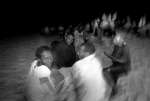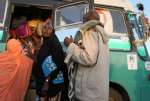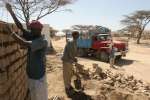- Text size
 |
|  |
|  |
| 
- Français
Famine victims converge on Mogadishu; region's camps report deaths
News Stories, 22 July 2011
GENEVA, July 22 (UNHCR) – Uprooted by famine and conflict, more than 20,000 desperate people have sought refuge in the Somali capital Mogadishu so far this month. Thousands more continue to flee into the region, some on the brink of death.
"Every day, an average of 1,000 people arrive in Mogadishu seeking help," said UNHCR spokeswoman Melissa Fleming in Geneva on Friday. "Most come from famine-struck areas such as Lower Shabelle and Bakool."
Through its partners, the UN refugee agency on Wednesday distributed emergency assistance packages benefiting 15,000 internally displaced Somalis in the Dharkenley district of south-west Mogadishu. An additional 7,500 packages will be distributed in the coming weeks, with each package containing a UNHCR tarpaulin for shelter, three blankets, a sleeping mat, two jerry cans and a full kitchen set and utensils.
"We are trying to provide aid where people are, to prevent them from taking the difficult journey to Kenya and Ethiopia," said Fleming.
Driven to desperation, many Somalis are still making that journey. Kenya's Dadaab camps are still receiving about 1,500 new Somali refugees every day while several hundred are arriving in Ethiopia's Dollo Ado area daily.
More than half of them come from the Gedo, Bay and Bakool areas of south-central Somalia. They say they were either pastoralists or farmers fleeing due to the persistent drought, as well as violence that forced them to abandon their farmlands and livestock.
This is a dire nutritional emergency.
Melissa Fleming
UNHCR chief spokeswoman
Many refugees are arriving in bad shape due to months of deprivation and the long trek to reach aid. "This is a dire nutritional emergency," said Fleming, noting that 15 deaths from malnutrition and other diseases were reported on Tuesday in Dollo Ado's Kobe camp. UNHCR staff in Dadaab are also reporting a rise in the number of deaths due to acute malnutrition, particularly among children.
Children younger than five years are the most vulnerable, but UNHCR is also concerned about malnutrition among refugees aged five to 18 years. "If treated early and correctly, most malnourished children can recover physically," said Dr Paul Spiegel, chief of UNHCR's Public Health and HIV section. "But the new arrivals with severe acute malnutrition seem to take longer than normal to recover, sometimes up to 6 to 8 weeks – possibly because of the horrendous state they are coming in."
All new arrivals in the camps are registered and given health screenings. The malnourished and people with medical complications are referred to clinics, including for therapeutic feeding.
At the Dollo Ado transit centre in Ethiopia, UNHCR is providing two hot meals a day for more than 11,000 new arrivals living in makeshift tents. The number of arrivals is outpacing the capacity to absorb them in this parched and remote area. Kobe camp, which opened last month, is already full with over 25,000 refugees. A new camp, Hilaweyn, is nearing completion and will hold up to 60,000 people. The relocation of refugees from the transit centre is expected to start within the next two weeks.
"Overcrowding is a problem in both Dadaab and Dollo Ado," said Fleming. "To ease congestion, UNHCR is continuing its airlift of emergency aid, including tents for more than 75,000 people."
Kenya and Ethiopia have received three flights each, bringing 100 tonnes of relief and shelter supplies per flight. From the capitals' airports, this aid is immediately sent on to the refugee-hosting border regions of Dadaab and Dollo Ado.
Kenya has received more than 100,000 Somalis so far this year, including 60,000 in the Dadaab area. Ethiopia has received over 75,000 Somali refugees since January, including more than 74,000 arrivals in the Dollo Ado area. Djibouti has received over 2,300 new Somali refugees so far this year.
UNHCR has deployed 60 emergency staff to the region to provide life-saving assistance to the new refugees, with another 11 on the way. The agency is seeking US$136 million in urgent funds to respond to this emergency till the end of the year.
















































